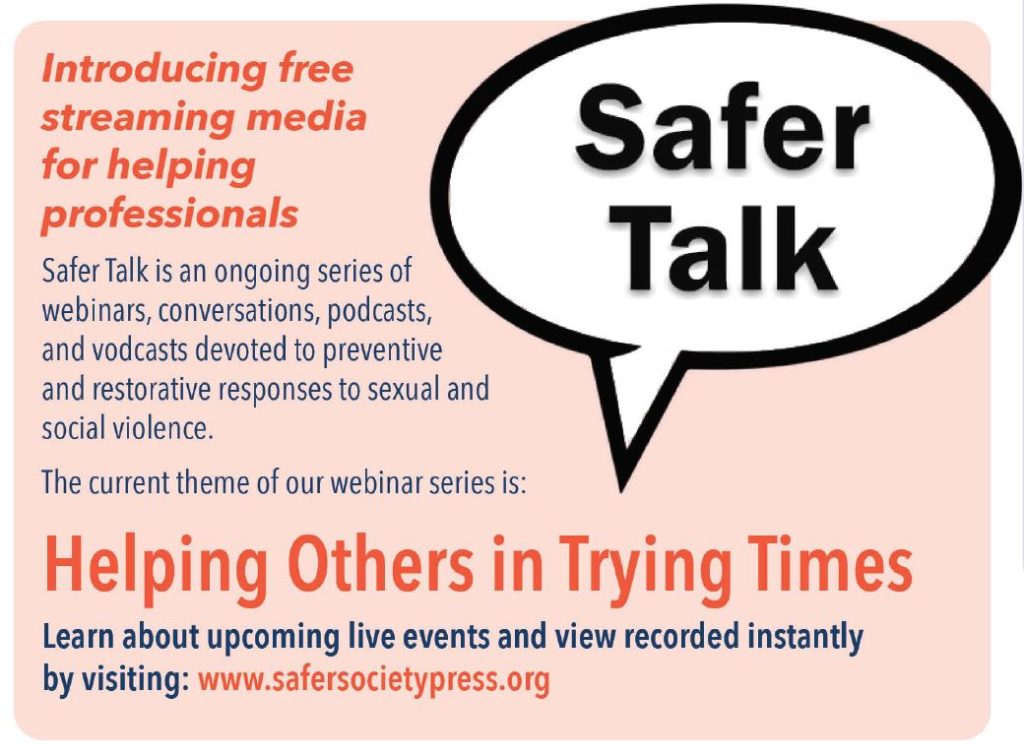Welcome to The New Circle
By Phil Rich, EdD, MSW
I am pleased to have the opportunity to serve as editor-in-chief of The New Circle, this venture to share ideas, resources, and solutions with the broad spectrum of professionals and paraprofessionals who work with at-risk children and teens. Everyone involved with the content of the magazine, from David Prescott, our publisher, to our editors and writers, speaks as a practitioner, working at—and closely tuned in to—the front lines of the work.
Why Another Resource for Those Working With At-Risk Youth?
The answer is, in part, that since its founding by Fay “Honey” Knopp in 1985, the Safer Society Foundation has been committed to helping build the skills and provide the resources needed by practitioners in order to work effectively, knowledgeably, and in an evidence-based manner with young people at risk for myriad difficulties throughout their lives. If not ameliorated, difficulties in behavioral, mental, and social health, physical health, and psychosocial and cognitive functioning, contribute to or fuel problems from childhood through adulthood.
Adding to the research and other essential resources provided by the academic journals of individual disciplines, which help guide our work, The New Circle reaches out to all those working with children and adolescents who are at risk across a range of environments, including the community, school, family, and peer group—providing the opportunity for sharing best practices on an interdisciplinary level, and describing, promoting, and encouraging evidence-based, or evidenceinformed, practices at all levels both within and across all disciplines. An interdisciplinary best practices model recognizes that risks can be ameliorated through supportive interventions that are geared individually for each child, and also that protective and promotive factors—those strengths, supports, assets, and positive relationships available to the young person—can be found and nurtured in the very environments in which risk can be found.
Supporting Evidence-Informed Practices
Best practices, which are almost by definition evidence-informed, are, as much as possible, based upon research that supports the efficacy and effectiveness of the things we do (our interventions and methods). Of course we want evidence that the things we do are based upon our best knowledge that those things actually work, but finding sure evidence is difficult and it may not fit every situation in which practitioners find themselves. Nevertheless, our goal is the promotion of evidence-informed ideas, approaches, and interventions, while ensuring an orientation that recognizes the importance of the individual situation and the application of research to interventions under real-life conditions, whether in the therapy office, the classroom, or the foster home, for instance.
What’s This First Issue All About?
This first issue sets our direction by reflecting on some of the challenges faced by practitioners, whether in the classroom, in therapy, in foster care, or mentoring, for instance, but importantly asks what can be done and what is necessary to “challenge the challenge” and overcome it. In each issue, David Prescott will frame and discuss an issue that pertains to practice, or front line work, and its administration.

In this issue, David succinctly frames our focus by asking, “What are helping professionals up against?” and discussing how we work with, address, and resolve many of the difficulties faced by practitioners in schools, agencies, and other environments serving at-risk youths. Becky Palmer describes the challenges faced by practitioners working with family violence, and the need for innovation in ensuring we bring needed services to the families of at-risk children, despite conditions and circumstances that present obstacles to this important work. Mary Falcon discusses the difficulties of funding the levels of mentoring services needed by at-risk children. Katelen Fortunati describes the challenges social workers face today as the result of America’s history of social and political change. Sarah Kull asks whether foster care, despite its strengths and mission, might in some or many cases exacerbate trauma rather than protect against it. Stuart Copans offers insight into the challenge of working with administrative systems that may be more focused on efficiency and cost containment than promoting effective helping relationships. Connie DelGiudice asks if helping professionals are prepared to deal with situations in which they suspect or recognize child abuse. Finally, and importantly, we ask and answer what we mean by “at-risk” when we talk about at-risk children and adolescents.
A key theme that echoes throughout this issue, as it will in all future issues, is trauma-informed care, and our ability to recognize adverse developmental experiences as a major source for the range of educational and psychosocial difficulties experienced by at-risk children and teenagers. It also refers to our need to approach work with at-risk young people in a trauma-informed manner, sensitive to the individual needs of our clients, students, and foster children, and the importance of the helping relationship itself as a major channel for healing, adjustment, effective learning, rehabilitation, and social growth.
What’s to Come in Future Issues?
A glance at the table of contents gives the clearest overview of the content of The New Circle, including its structure, with articles largely grouped under the color coded Helping Professions, Helping Interventions, and Childhood Adversity. Grouped into these three primary sections, future issues will include articles addressing social work, education, juvenile justice, counseling, psychiatry, and family therapy; foster care, daycare, and mentoring; and poverty, child abuse, neglect, and other adverse child and adolescent experiences; although not all of these focal areas will be included in every issue.
Together, the articles in Issue 1 of The New Circle set the pace and build a foundation for the forum we intend to provide in future issues, presenting a collection of articles and ideas that help us think about the work we do and how we can ensure that we continue to provide such important services to children and adolescents who are at risk for a variety of difficulties.
I hope this brief introduction both gives you a sense of where we intend to head—and why we intend to head there—and the contents and themes of this, our first, issue. If you would like to provide feedback, comments, or suggestions for topics you’d like to see covered in future issues, click on the link in The Mailbag. We are eager to hear from you! Selected reader comments will be published in the next issue of the magazine. Click on the Submissions link if you would like to submit an article to a future issue of The New Circle. And click on Contact Us if you have any questions or comments you’d like to direct to the magazine editors and/or Safer Society Foundation management.

Finally, we thank Stu Copans for brightening our days with his cartoons and we hope they will bring a smile to your face. If you enjoy a challenge to your inner humorist, check out Caption This, our cartoon caption “contest” where we invite you to submit a funny caption to a Stu Copans cartoon. Those voted the three funniest by the magazine Team will be published in the next issue.
And stay well. A cardinal rule for all those in the helping professions, in all roles: Self-care is of primary importance.


Phil Rich, EdD, MSW
Phil Rich, presents, trains, and consults nationally and internationally, specializing in work with children with sexual behavior problems and adolescents and young adults who have engaged in sexually abusive behavior. Phil holds a doctorate in applied behavioral and organizational studies and a master’s degree in social work. He has been the director of six residential or day treatment programs and has worked in outpatient and partial and inpatient hospital care and, in his early days, as a street outreach worker. Phil is the author of several books that address work with sexually abusive youth, as well as a number of books focused on general mental health.
